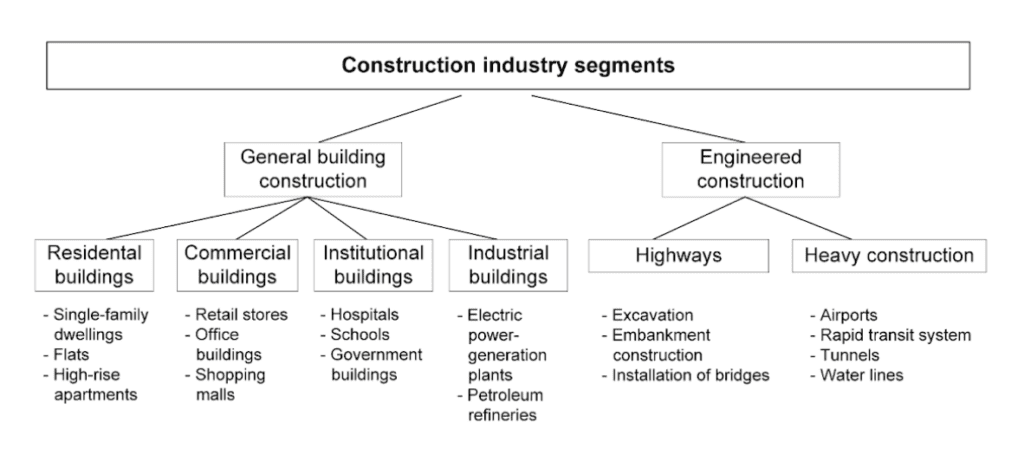What are the different types of construction projects?
A construction project is as a series of interrelated construction tasks which are undertaken in a systematic order over a temporary timeframe. It results in the completion of the project and the creation of a tangible product or outcome.
The type of processes involved in a construction project are things like constructing, refurbishing and/or the renovation of a building, structure, or infrastructure. The construction industry can be segmented into two general components: general building construction and engineered construction which each includes more construction-specific segments that you can see in the figure below.

There are three types of construction project:
- a public project
- a private project
- a public private partnership.
Public Project
A public project is a project which is predominantly funded by a government body and will be maintained/operated by the government when in service. In public construction projects this can include major infrastructure such as highways, bridges and railways etc. or public institutions such as hospitals, schools and prisons.

Public projects are funded by tax revenue and therefore involve more rigorous bidding and contract award processes than other types of construction projects. Bids submitted for public projects usually must meet specific requirements based on cost, quality and project-specific impact. Project impact can relate to climate change impact, local employment in the construction project or other social and environmental impacts as a result of the construction project. Usually, public construction projects comprise a lengthy public and stakeholder consultation process throughout all stages of the project. This exposes the project to public scrutiny and assessment.
Private Project
Unlike public construction projects, private construction projects are commissioned, funded or controlled by a private entity such as individual developers, private corporations or charities rather than governmental or publicly funded organisations.

You can find out more about the difference in this video.
Public Private Partnership
A Public Private Partnership (PPP) involves a construction project which has been commissioned, financed or controlled by both a public and private entity. Such Public Private Partnerships involve a unique partnership between the public and private organisation to complete the construction of a specific project.

You can see an outline of a PPP in construction here.
If you work in construction it is likely that you might be involved in all three of these types of projects, so it is important to know what they are and what types of buildings are covered in each.
We’ll also be covering the different types of construction projects, the people involved and documentation needed in other posts if want to dive deeper.
Interested in our courses?
Interested in civil engineering? Find out more about all the civil engineering courses we have available by clicking here.
Diploma in Sustainable Construction
Diploma in Structural Engineering
Diploma in Building and Construction Engineering
Higher International Certificate in Civil Engineering
Higher International Diploma in Civil Engineering
Alternatively, you can view all our online engineering courses here.
Recent Posts
From Sparks to Strength: Top Welding Techniques You Should Know
From Sparks to Strength: Top Welding Techniques You Should Know Introduction From spark to structural bond—that’s the transformative power of welding. In the iLearn Engineering® article “From Sparks to Strength: Top Welding Techniques You Should Know,” readers are guided through essential welding methods—such as SMAW, MIG, TIG, and spot welding—each selected for strength, speed, or […]
Enhancing Materials: A Look into Surface Treatment Processes
Enhancing Materials: A Look into Surface Treatment Processes Introduction In manufacturing, selecting a material with the right bulk properties is only half the story. The performance of a component often hinges on what happens at its surface. The iLearn Engineering® article explores how various surface treatment processes—from coatings and plating, to shot peening, anodizing, and […]
How Material Removal Rate Affects Surface Quality and Production Speed
How Material Removal Rate Affects Surface Quality and Production Speed Introduction When machining components, one of the most critical—and often overlooked—factors is the material removal rate (MRR). It’s a common assumption that increasing MRR boosts productivity. However, as this iLearn Engineering article explains, this simple equation comes with important trade‑offs. Pushing MRR too high can […]

